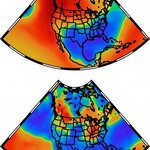Atmospheric

Optics researchers from the University of Central Florida's College of Optics&Photonics and the University of Arizona are working on a new technique to aim a high-energy laser beam into clouds to make it rain or trigger lightning. They are developing the a technique to surround a primary beam with a second beam that acts as an energy reservoir, sustaining the central beam to greater distances than previously possible.
The secondary "dress" beam refuels and helps prevent the dissipation of the high-intensity primary beam, which on its own would break down quickly.
Water condensation and…

Last winter's curvy jet stream pattern brought mild temperatures to western North America and harsh cold to the East and it may have seemed exceptional in the era of 24-hour news, but it's been happening that way for about 4,000 years, according to a new study.
It is not new for scientists to forecast that the current warming of Earth's climate due to carbon dioxide, methane and other "greenhouse" gases already has led to increased weather extremes and will continue to do so. The new study is based mainly on isotope ratios at Buckeye Creek Cave, W. Va.; Lake Grinell, N.J.; Oregon Caves…

Since the discovery of the Antarctic ozone hole, scientists, policymakers, and the public have wondered whether we might someday see a similarly extreme depletion of ozone over the Arctic.
A new MIT study finds it isn't a big worry. In the 30 years of international efforts to limit ozone-depleting chemicals, ozone levels in the Arctic haven't yet sunk to Antarctica levels. Picking one solution and declaring it the savior may not be valid; in Canada, ozone-depleting chemicals dropped but ozone still went up, forcing policymakers to scramble and claim it must be coming from Asia.
Regardless,…

A study by has determined that, on average nationally, minorities are exposed to 38 percent higher levels of nitrogen dioxide (NO2) outdoor air pollution compared to white people.
Nitrogen dioxide comes from sources like vehicle exhaust and power plants. Breathing NO2 is linked to asthma symptoms and heart disease. The Environmental Protection Agency has listed it as one of the seven key air pollutants it monitors. The researchers studied NO2 levels in urban areas across the country and compared specific areas within the cities based on populations defined in the U.S. Census as “nonwhite” or…

Global warming may be a topic of debate and arguments about measurements and models, but some things are measurable right now, like environmental pollutants.
Although persistent environmental pollutants are released worldwide, the Arctic and Antarctic regions are significantly more contaminated with persistent organic pollutants than elsewhere; marine animals living there have some of the highest levels of persistent organic pollutant (POP) contamination of any creatures and the Inuit people of the Arctic, who rely on a diet of fish, seals and whales, have also been shown to have…

An analysis of temperature data since 1500 A.D. all but rules out the possibility that global warming in the industrial era is a natural fluctuation of climate, according to a paper in Climate Dynamics.
The study examined historical data to assess the hypothesis that warming over the past century is due to natural long-term variations in temperature. These "multi-proxy climate reconstructions" have been developed to estimate historical temperatures, as well as fluctuation-analysis techniques from nonlinear geophysics.
The climate reconstructions take into account a variety of…

The rise and fall of acid rain is a global experiment whose results are preserved in the geologic record and in Greenland ice sheet samples, which discovered a link between air acidity and how nitrogen is preserved in layers of snow, University of Washington atmospheric scientists say the U.S. Clean Air Act worked.
Writing in the Proceedings of the National Academy of Sciences, the authors say that 45 years ago, acid rain was implicated in dead fish and dissolving stone monuments on the East Coast. Air pollution rose beginning with the Industrial Revolution and started to improve…

Vapor losses to the walls of laboratory chambers haven't been properly factored in, according to a new PNAS paper, and that has caused researchers to underestimate the formation of secondary organic aerosol in the atmosphere. It also brings up a lot of questions about what other simplistic mistakes have led to all kinds of air quality claims.
Vapor losses can suppress the formation of secondary organic aerosol, which in turn has contributed to the under-prediction of secondary organic aerosol
(SOA) in climate and air quality models. Secondary organic aerosols are formed primarily through…

Arid areas are among the biggest (non-ocean) ecosystems we have and it turns out they take up higher levels of carbon as levels of carbon dioxide increase in the atmosphere.
The findings give scientists a better idea of the earth's "carbon budget" — how much carbon remains in the atmosphere as CO2 and is a concern for global warming and how much actually gets stored in the land or ocean in other carbon-containing forms.
The findings result from a 10-year experiment in which researchers exposed plots in the Mojave Desert to elevated carbon-dioxide levels similar to those expected in 2050. The…

Scientific uncertainly prevents definitive solutions (beyond putting a stop to the world and leaving poor people to a future with no food, water or air conditioning) but the stance that the issue is settled, even when solutions may not be effective, also leads to public mistrust and name-calling.
But that uncertainty should actually make us more rather than less concerned about climate change, according to two papers in Climatic Change which investigated the mathematics of uncertainty in the climate system and showed that increased scientific uncertainty necessitates even greater action to…